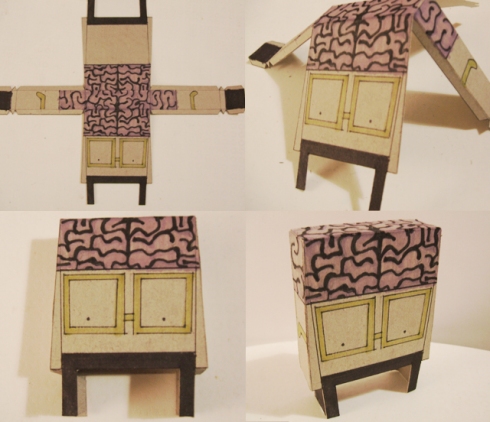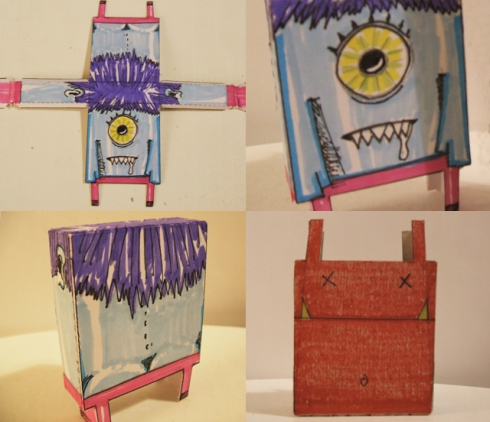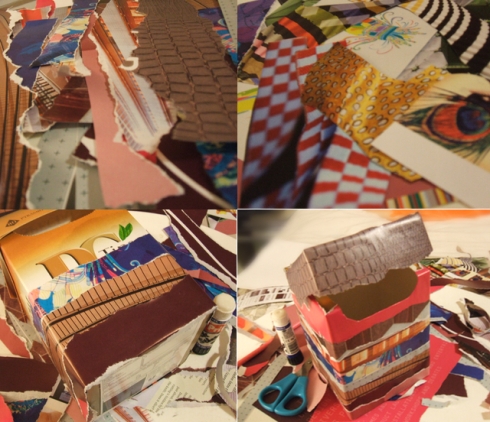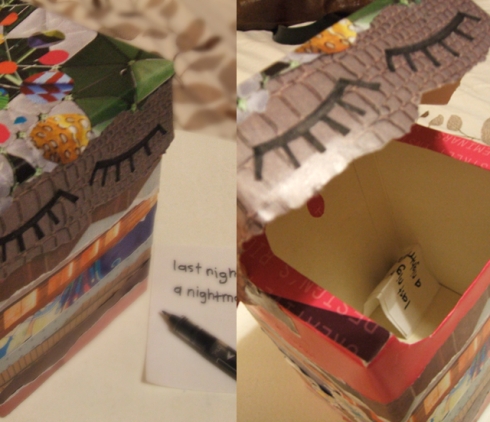A magician is not supposed to reveal his tricks, but this time I`ll make an exception … wanna know how to make your hand (or anything really) disappear?

© 2011 Fernanda de Uriarte
Ta-da!
It´ll take you around 2 -2 1/2 hours to make your invisibility box.
You´ll need:
_A border-less mirror.
_Mount board or any other type of thick cardboard (about 2-3 mm thick). I used black cause we´re doing magic! but you can choose any colour you want.
_A piece of acetate.. It could be that you recycle a plastic packaging or something similar. I actually used the pack of my mirror.
_Double sided tape.
_Ruler.
_Pencil/pen.
_Cutter and cutting mat or a surface to cut on.
_Coloured tape to cover the edges if they don´t look that nice (that´s the downside of using black: every little detail shows!)
_You might need a bit of maths skills for this one, but nothing to worry.. I`ll show you what to do.
How to make an Invisibility Box:
Before we go to the detailed instructions, let me explain a little so that you what I`m talking about all the way through:
The invisibility box works by placing a mirror diagonally inside the box. That way, you get half a box “obscured” from the view of your public and the mirror does the trick by creating the illusion of looking at the whole box through the window at the front. When you put your hand or any other object inside the box you fill the “obscured” part of the box, and because of the mirror illusion, it looks as if your hand was disappearing as it goes inside.
It will be hard for us to find exactly the same size of mirror, that´s why instead of giving you exact measures, I`ll show you how to figure out the dimensions of your box, depending on the size of the mirror you find.
Let´s do it step by step:
1. We´ll start with the maths (yaaay!).
The mirror will be placed at 45º inside the box. That means that the height and depth will have the same dimensions. We`re using Pythagoras theorem to calculate the sides of a right triangle (the sides of the triangle will be the sides of your box). I have simplified and written the formula for you to replace the letters with the right numbers.
The width of your box is the same as the width of your mirror.
Check the diagrams below:

© 2011 Fernanda de Uriarte
2. On the mountboard/cardboard, draw a rectangle the same length and width as your mirror and add about 4 cm. to both ends, lengthwise (8cm. total)
3. Cut the rectangle, including the extra 8 cm; pass the cutter a couple of times of the lines dividing the original rectangle from the extra length, make sure not to cut all the way through.
4. Bend these extra length bits back.
5. Put some double sided tape on the back of your mirror and stick it to the piece you just made.
6. Once you’ve figured out the dimensions of the box, draw a net, on the mountboard/cardboard to make the actual box. (check this posts out to see a few examples of nets so you know how to make yours camera obscura, Spyscope, cubic Transformers). Make sure you make 2 openings: 1 for your hand and other objects to go in and another one to let your audience see the trick; I`ll call the later “the window”.
7. Cut out and score (pass the cutter without going all the way through) where needed.

© 2011 Fernanda de Uriarte
8. Cut a piece of acetate the size of the window plus 5mm on every side. So, if for example, your window is 10cm x 10cm, your piece of acetate will be 11cm x 11 cm.
9. Use some tape to attach the piece of acetate to the window, on the side that will go inside the box.
10. Stick some double sided tape to the tabs (extra bendy bits of your box-to-be)
11. Start folding and sticking the whole thing together. Don´t close it yet! we still have to put the mirror in.

© 2011 Fernanda de Uriarte
12. Remember the cardboard piece with the mirror from the beginning? Get it and stick it with the mirror facing down and towards the acetate window. (check the image below)
13. “Close” the box.
14. If you like, you can use the colour tape to cover the white/not so nice edges and make your box all black and nice.

© 2011 Fernanda de Uriarte
Invisibility box ready to do the trick!
Just stick your hand in and watch it disappear in front of everyone’s eyes.

© 2011 Fernanda de Uriarte
You could also do it the other way around… hide something inside the box and make it appear when you take your hand out.
And remember… a magician never reveals the trick.
(SHHHHHHHHHHH!)
Tags: box, cardboard, disappear, invisible, magic, mirror, trick






































